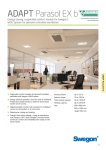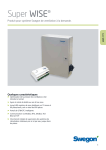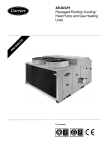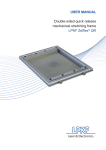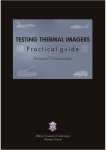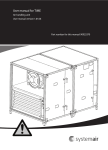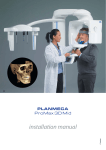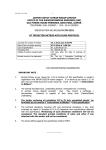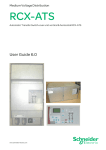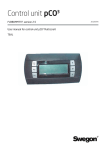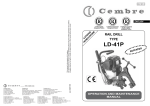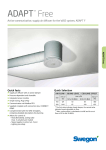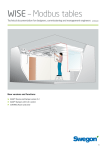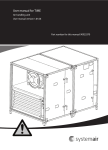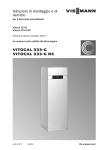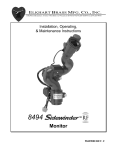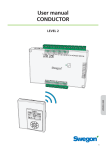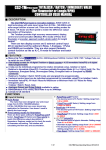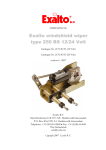Download ADAPT Parasol b
Transcript
ADAPT Parasol b Energy-saving comfort module for Swegon’s WISE System for demand-controlled ventilation www.eurovent-certification.com www.certiflash.com ADAPT Parasol b Quick facts Quick guide ►► Comfort modules for demand-controlled ventilation and Swegon’s WISE system. Primary airflow: Up to 85 l/s Pressure range: 50 to 150 Pa ►► Energy-efficient operation since the room is ventilated, heated and cooled exactly as called for by the load, neither more or less. Total cooling capacity: Up to 2,055 W Heating capacity: Water: Up to 2,700 W ►► Highest possible comfort with provision for individual control on the product or at room level. ►► Waterborne cooling energy and waterborne or electric heat Electric: Up to 1,000 W Size: 600 and 1200 with adapters for a number of ceiling systems ►► Draught-free indoor climate, 4-way air distribution and Swegon’s ADC (Anti Draught Control) provide maximum comfort and flexibility both today and for future needs. ►► Simple installation, commissioning and maintenance. Complete product with all components and accessories installed from the factory. 1 ADAPT Parasol b Flexibility The easily adjustable nozzles in combination with Swegon’s ADC (Anti Draught Control) offer maximum flexibility for future changes in the room layout. All sides of the unit can be set independently of one another and this enables the comfort module to distribute more air or less air to each of the four sides and deliver the air in the preferred direction in the room. Design The face plate of the ADAPT Parasol is available in three different perforation patterns. As standard, the face plate has round perforations arranged in a triangular pattern however other optional patterns are available to special order. ADAPT Parasol comfort module The ADAPT Parasol is based on a standard Parasol but is equipped with functions for demand control of the indoor climate. Available as single and two-module units: Sizes: 600x600; 600x1200 Modules: Supply air and cooling Supply air, cooling and heating (water) Supply air, cooling and heating (electric) Installation: Flush mounting in suspended ceiling Function The essential function of the comfort modules is closely related to that of climate beams. The major difference is that comfort modules distribute air in four directions instead of two. This maximizes the area for the induction of room air with the supply air which enables the modules to deliver a high capacity without occupying more ceiling space than necessary. The comfort modules are also optimized to quickly mix the supplied air with the room which provides better comfort in the room. In heating applications, this technique also ensures heat is conveyed along the ceiling in a better way. Draught-fee indoor climate The ADAPT Parasol distributes air in four directions at low air velocity. The low air velocity is created by distributing air cooler than room temperature over a large area. The special design of the outlet creates a turbulent flow enabling the supply air to be quickly mixed with the room air. The comfort module’s closed design with a circulation opening for recirculated air in the face plate of the module also contributes to its excellent mixing performance. The ADAPT Parasol is available in the following coil/heat exchanger variants: Variant A: Supply air and waterborne cooling energy from coil. Variant B: Supply air, waterborne cooling energy and heat from coil. Variant X: Supply air, waterborne cooling energy and heat from electric heating elements. Demand-controlled indoor climate Demand-controlled ventilation involves ventilating and conditioning the air in a room precisely to meet our needs – no more and no less. The potential for savings is substantial, especially in premises where there is considerable variation between low and high load conditions in rooms and during times when there are few or no occupants which is the case in many premises. Offices for example have in many cases an occupancy rate of less than 50 %! The ADAPT Parasol combines the best attributes from two worlds – demand-controlled ventilation with all its potential for savings combined with the comfort module’s high capacity and performance for air conditioning rooms. All this packaged in one compact unit is simple to install. 2 Swegon reserves the right to alter specifications. 2015-12-16 www.swegon.com ADAPT Parasol b 1 1 3 3 3 3 2 2 3 3 3 3 Figure 3. Variant X: Supply air and heating operation with electric heating elements (also includes cooling function) Figure 1. Variant A: Cooling and supply air operation 1 = Primary air 2 = Induced room air 3 = Primary air mixed with chilled room air 1 = Primary air 2 = Induced room air 3 = Primary air mixed with heated room air 1 3 3 ADAPT Parasol b 2 3 3 Figure 2. Variant B: Heating and supply air operation (includes also cooling operation) 1 = Primary air 2 = Induced room air 3 = Primary air mixed with heated room air Swegon reserves the right to alter specifications. 2015-12-16 www.swegon.com 3 ADAPT Parasol b Compact and intelligent unit The ADAPT Parasol is supplied as a compact and intelligent unit in which the damper and control equipment is integrated into the product. Only the power supply and possible connection to a main control system need to be wired from the module. The sensor module, which is a vital part of the product, is a combined presence detector and a temperature sensor. Its default location is within the face plate, however it can also be mounted on a wall. The package together with its intelligent control system where numerous adaptations can be made, contribute to making the product very flexible and future proof. As an example, it is noteworthy that all the units can operate as master or slave, simply adjustable by changing a parameter together with repositioning an RJ cable. This means that in the event an open-plan office, for example, is divided up into office cells, the extra work involved in adapting the product to the new operating conditions is minimized. Range of Application The ADAPT Parasol is ideal as a standard application in the following typical premises: • • • • • • • Offices and conference rooms Classrooms Hotels Restaurants Hospitals Shops Shopping centres With its numerous possible settings, the functions of the ADAPT Parasol can easily be adapted to new businesses or changes in the design of the premises. Simple to install The ADAPT Parasol’s small compact units are designed to fit the most common modular ceiling dimensions and this makes them simple to install. The small dimensions offer benefits in handling, especially at the building site, with easier installation and reduced health and safety issues. ADAPT Parasol PlusFlow If you need both high cooling capacity and high airflows, then the ADAPT Parasol 600/1200 PF is the right choice. ADAPT Parasol PF installed in a conference room, for instance, can reduce the number of installed products by 50%. The module can handle large airflows and at the same time has the same high cooling and heating capacity as a standard ADAPT Parasol, of course with maintained high level of comfort in the room. Market-standardised modular dimensions The products available to order have modular dimensions to fit the standardised 600, 625 and 675 mm centre-tocentre ceiling dimensions. There are also mounting frames for plasterboard ceilings as well as solutions for clip-in type ceilings. Always in stock High capacity With its high capacity, the ADAPT Parasol utilizes 40-50% less ceiling area for handling the cooling energy demand in a normal office, compared with a traditional climate beam. The ADAPT Parasol’s standard variants with the most common functions are available from stock to keep delivery times short. Simple to adjust By means of built-in nozzle regulation with numerous possible settings, the ADAPT Parasol offers optimum comfort and can be easily adapted to meet a change in room size or operations conducted inside the premises. The comfort module can be set so that different air volumes are diffused on each side and can be set for both high and low airflows. 4 Swegon reserves the right to alter specifications. 2015-12-16 www.swegon.com ADAPT Parasol b All components in the product can be installed directly from the factory Electrical connections All factory-fitted components are wired to wiring terminals. Transformer Pressure sensor Motor for damper blade. Valves and actuators for cooling and heating. ADC (-40° to +40° angle). Can be preset from the factory. Controller. Preconfigured from the factory VOC or CO2 sensor. Sensor module with temperature and presence detector. Adjustable nozzle setting on all four sides. Preset from the factory ADAPT Parasol b Figure 4. All components in the product can be installed directly from the factory. * temperature measurement from the sensor module mounted in the face-plate is not recommended in the case of heating. Swegon reserves the right to alter specifications. 2015-12-16 www.swegon.com 5 ruktur ADAPT Parasol b Chiller and heat pump NESTOR ruktur ystem Internal network/ Internet Central intelligent building automation System ystem ruktur ruktur ystem Zone ystem Subsystem All Year Comfort Super WISE ystem Zone Room ystem GOLD ystem Room roduct Zone Zone roduct ) Zone parts Room CONTROL Zone CONTROL Zone CONTROL Zone )Room parts onents roduct Room roduct onents ) parts ADAPT Damper ) parts onents onents Passive air diffusers ADAPT active air diffusers ADAPT Parasol Figure 5. Component of the WISE system The ADAPT Parasol is a component of Swegon’s WISE System for demand-controlled ventilation. Via the SuperWISE, a communication unit, which, via Modbus RTU, ties all the components in the WISE system together, ADAPT Parasol communicates with other WISE products in the system and all the way up to the GOLD air handling unit. 6 Swegon reserves the right to alter specifications. One of the advantages with the ADAPT Parasol is that the pressure in the nozzles can be kept at a high level, and this means controlled throw lengths, high capacity and maintained Coanda effect of the air regardless of the operating conditions. The Swegon CONTROL Zone damper is used for maintaining constant pressure in the zone. 2015-12-16 www.swegon.com ADAPT Parasol b Demand-controls the climate in the room • Stepless regulation of the airflow as required – temperature or the air quality. • If an air quality sensor is used, it overrides the temperature sensor. • Same stepless function regardless of whether it concerns one product in an individual-room office or several products in an open-plan office or a conference room. • Besides ventilating in an efficient way, the room temperature is regulated by means of both waterborne and airborne cooling. • Can advantageously discharge heated air from the ceiling – all in one product • Can be combined with radiators or floor heating – the product then takes this into consideration and regulates the room temperature in an energy-efficient way, for example by increasing the airflow on increased heat demand. Selection of sequence, Water / Air • T he control sequence involves prioritising waterborne cooling before airborne cooling • For an occupied room, the airflow is steplessly regulated between min. and max. depending on the room temperature (or the air quality if an air quality sensor is used). • If the room needs to be cooled, ensure first that the airflow generates sufficient pressure in the module which will allow the water valve to open. The reason for this is to ensure comfort in the room, i.e. to prevent cold down draughts from the product. • After that the water valve is allowed to open to supply chilled air to cool the room. If there is still a cooling demand when the cooling valve is fully open, the built-in air damper opens to cool more with air. Flow Water / Air 1 2 3 4 5 6 Max. occupancy flow ADAPT Parasol b Min. P cooling valve Min. occupancy flow Valve 100% open Vacancy flow Valve 0% open Occupancy with cooling demand Figure 6. 1. Occupancy – temperature rises 2. The room temperature reaches level for cooling demand – air damper opens in order to reach minimum pressure which alllows cooling valve to open. 3. Cooling valve is allowed to open 4. Cooling valve is fully open but there is still a cooling demand in the room – the air damper opens in order to cool with more air 5. Cooling valve and air damper fully open 6. The temperature reaches the room set point; the damper and valve close = Water = Air = Room temperature Swegon reserves the right to alter specifications. 2015-12-16 www.swegon.com 7 ADAPT Parasol b Selection of sequence, Air / Water • T he control sequence involves prioritising airborne cooling before waterborne cooling • For an occupied room, the airflow is steplessly regulated between min. and max. depending on the room temperature (or the air quality if an air quality sensor is used). • If there is a cooling demand, the air damper first steplessly opens to the fully open position; if a cooling demand remains the water valve also opens. Flow Water / Air 1 2 3 5 4 Max. occupancy flow Min. occupancy flow Valve 100% open Vacancy flow Valve 0% open Occupancy with cooling demand = Water = Air Figure 7. = Room temperature 1. Occupancy – temperature rises 2. Room temperature reaches level for cooling demand – air damper opens 3. Cooling valve is fully open but cooling is still required in the room – the valve opens in order to cool with water 4. Air damper and water valve fully open 5. The temperature reaches the room set point; the damper and valve close Sequence, Air quality Flow / Air 1 2 4 3 Max. occupancy flow Min. occupancy flow Vacancy flow Occupancy with increased airflow to improve air quality = Air Figure 8. = Room temperature 1. Occupancy – CO2 / VOC content rises 2. CO2 / VOC content reaches the permissible upper limit value – the air damper steplessly opens 3. Fully open air damper 4. CO2 / VOC content reaches the permissible lower limit value – the air damper closes 8 Swegon reserves the right to alter specifications. 2015-12-16 www.swegon.com ADAPT Parasol b Operating mode Depending on the status of connected sensors, the controller adjusts the outputs from any of several possible operating conditions. The operating conditions based on occupancy in the room, the status of the sensor in use or signals from a main control system are described below. Operating modes There are numerous functions in the ADAPT Parasol: • Occupancy mode. • No occupancy mode. • Stand-by, idle mode. • Emergency mode. • • Emergency mode In the event of a fire alarm, the controller opens or closes the air damper in the extract air duct, depending on how the control system is set. In the Emergency mode, cooling and heating are switched off. Supply air is normally switched off. Holiday. • Stand-by, idle mode When the control system registers that a window is open, the controller switches over to the Stand-by mode. When the window is closed, the controller switches over to the Occupancy mode. The controller is in the Stand-by mode, the room temperature is kept above 10°C (frost protection). The Emergency mode can only be managed in control systems that are connected to a main control system via Modbus RTU. Commissioning. Summer night cooling. Commissioning level The “First open” function involves having the water valves open while the installation work is in progress, which simplifies filling, pressure testing and venting the water system The function will be automatically deactivated after approx. 6 minutes while the system is energised. A clicking noise can be heard when the valves and dampers change over to the NC mode (normally closed) and the normal control function is activated. Further particulars of the commissioning mode can be read in the description of the sensor module on page 12. No occupancy mode When the No occupancy mode function is active, the system automatically switches over to the energy-save mode. The system returns to the Occupancy mode and normal operation when occupancy is registered again. In the energy-save mode/no occupancy mode, the valve actuator is controlled to regulate the chilled water flow or hot water flow according to the status on other sensors in the room, but normally with a greater permissible deadband from the temperature setpoint for cooling or heating than in the occupancy mode, whilst the air is controlled to the min. flow setting. Summer night cool The function involves the use of cold air from outdoors for cooling the room at night to the predefined level. The function can only be handled in the control system that is connected to a main control system via Modbus RTU. Holiday. When the Holiday operating mode is active, the system automatically switches over to the energy-save mode just as in the case of the No Occupancy mode, but with scope for allowing further greater temperature differential. Controlled from a main control system. Swegon reserves the right to alter specifications. 2015-12-16 www.swegon.com 9 ADAPT Parasol b Occupancy mode When the ADAPT Parasol receives signals via presence detector that someone is in the room, the valve actuator for chilled water or heating water as the case may be is controlled according to the selected temperature setpoint for cooling or heating associated with this operating mode. The airflow is controlled to the preselected occupancy flow, but is influenced of course by sensors such as condensation sensors, temperature sensors, window contacts, air quality sensors, if required, etc. ADAPT Parasol b Functions SWICCT: Change over The function involves the use of only one valve actuator which should be wired to the cooling output terminal. This actuator then controls both the heating water and the chilled water, which is transported in the same pipe. An external temp. sensor should be used and this component should take measurements on the pipe through which water always circulates. In winter, when heating is required, the valve opens if the water in the pipe is warmer than the temperature set point. If the water is colder, the valve does not open. In summer, when cooling is required, the valve opens if the water in the pipe is colder than the temperature set point. GT1 GT2 RE External temperature sensor use Change over temperature Not used Room temperature Change over temperature Temperature (read only) Window contact NO Window contact NC Figure 10. Exercising of valves The function involves exercising the water valves regularly by means of automatic control equipment to prevent them from seizing or becoming stuck. During the exercising process, all the valves wired to the controller open to the max. setting for 6 minutes and then close. The valves of the cooling system are exercised first; after that the valves of the heating system are exercised. Frost protection The function involves starting heating operation at 10°C to prevent the risk of damage that otherwise could occur due to freezing. ADAPT Parasol Room Figure 9. • 2-pipe system with chilled water in the summer and heated water in the winter • GT1 is located where heated or chilled water always circulates • Summer: If the room temperature T2 is higher than the water temperature T1 the valve opens if there is a cooling demand. • Winter: If the room temperature T2 is lower than the water temperature T1 the valve opens if there is a heating demand. • GT1 is wired to the controller as an external temperature sensor. • In the SWICCT or SuperWISE, the operator has enter a setting in the controller indicating that the sensor is to be used for Change-Over operation. • GT2 is the temperature sensor that is mounted in the Sensor module • The valve actuator should be wired to the cooling output of the controller. 10 Swegon reserves the right to alter specifications. 2015-12-16 www.swegon.com ADAPT Parasol b Specific nozzle settings To specify optimised nozzle settings, always begin from the side where the cooling water connections are located. From there, proceed in a counter-clockwise direction and specify side after side. See Figures 11 and 12. If you like, you can order the units preset from the factory (does not apply to units held in stock). K-factors for each side can be obtained from Tables 2-5 or from the installation instructions on the Internet, however the easiest way to do this is in ProSelect where you can quickly test various variants. Nozzle setting The unique built-in nozzle control in the ADAPT Parasol makes it possible to individually set each one of the four sides. Depending on the unit’s location and the room’s primary air requirement, the primary air can be guided in all desired directions. The direction of the airflow can be easily optimized using the Swegon ProSelect sizing program that is available from www.swegon.com. The required nozzle setting is preset from the factory, but if required it can be simply changed at the site. Figure 11. Top view, Pages 1 – 4 Figure 12. Top view, Pages 1 – 4 ADAPT Parasol 1200 ADAPT Parasol 600 A A B B B A Figure 13. Example 1. A = 2.1 l/s, B = 15.4 l/s Each nozzle setting has a specific K-factor. A total K-factor for the unit can be determined by adding together the K-factors for the nozzle settings on each side. The relevant K-factor for optimized nozzle setting can also be obtained in ProSelect. ADAPT Parasol b B K-factor A Figure 14. Example 2. A = 5.7 l/s, B = 15.25 l/s Example 1: Nozzle setting LHLH produces the lowest possible No Occupancy flow (sides 1 + 3 open). This produces a min. flow/No Occupancy flow of 4.2 l/s and a max. flow of 35 l/s at pi = 70 pa Example 2: If it is instead more important to obtain the highest possible max. flow/capacity, the nozzles should be set to the HHHH position, i.e. fully open on all sides. A higher max. flow will then be obtained, however the No Occupancy flow will consequently also be slightly higher. Figure 15. Nozzle setting These adjustments are only different settings on the same physical product which makes the unit very flexible and adaptable, particularly together with the integrated software. Swegon reserves the right to alter specifications. 2015-12-16 www.swegon.com 11 ADAPT Parasol b The sensor module The sensor module consists of a presence detector and a temperature sensor in the same unit. This component is mounted as standard in the face plate on the ADAPT Parasol but it can also be ordered as an accessory for wall mounting, and in that case either recessed in a standard electrical component box or surface-mounted on the wall. By pressing the appropriate buttons on the sensor module, you can adjust the temperature in the room, set the ADAPT Parasol to the commissioning mode and read the alarm list. 6 light-emitting diodes indicate in the normal mode which temperature level has been selected. If an error occurs, the current alarm is shown as a series of flashes that are translatable using an alarm list. Use an RJ12 cable to connect the sensor module to the controller. The floor area covered by the presence detector is approx. 24 m2 if it is mounted at a height of 2.7 metres above the floor and in parallel with the floor. Entering temperature adjustments To lower the temperature setting, press down the left-hand button. To raise the temperature setting, press down the right-hand button. Each diode corresponds to a one degree increase or decrease of the set point. The base setting of temperatures is entered in SWICCT or SuperWISE Presence detector Diodes for temperature, commissioning or alarm indication Figure 18. The CABLE CONVERTER USB-RJ12 (RS485) cable can be easily used for connecting a computer to the module for e.g. entering software settings. The cable can be connected either to a socket on the rear of the Sensor module as illustrated, or directly to the controller. How this is done is described in the SWICCT user's manual. Function buttons Diode-indicating function - Green = Ok - Flashing Green = Condensation alarm - Yellow = Alarm - Green/Yellow = Comfort alarm (not acute) Temperature sensor Figure 16. Sensor module viewed from the front ON 1 2 3 parallel RJ12 ports (Modbus) for connecting a controller for instance, another sensor module or computer by means of Cable converter USB-RJ12 Addressing the sensor module. 10 sensor modules can be connected to each master unit. Each one must have its own unique address in order to work. Switch for termination resistance. Set Switch 1 to the ON position for the last sensor module in the loop. Figure 17. Sensor module viewed from rear 12 Swegon reserves the right to alter specifications. 2015-12-16 www.swegon.com ADAPT Parasol b SWICCT SWICCT (SWegon Indoor Climate Configuration Tool) is the software that makes the entering of settings into the controller a simple task. Here you can make all the necessary settings for the Product, for example: • • • • Base settings for temperature how to use external sensors, e.g. for air quality Airflows Commissioning ADAPT Parasol b SWICCT can be downloaded from www.swegon.se; both the software and a separate manual. Swegon reserves the right to alter specifications. 2015-12-16 www.swegon.com 13 ADAPT Parasol b Typical installations: 2 GP 2 2 2 GP GP GP x3 3 RE RE 1 1 4 5 3 6 4 6 5 Figure 19. Typical room 1 shows ADAPT Parasol in an office room Extract air via transfer air grille (balance at zone level) Figure 20. Typical room 2 shows ADAPT Parasol in an office room Supply and extract air in balance. 1. ADAPT Parasol comfort module with supply air, cooling and heating • Pressure sensor • Communication unit/controller • Damper with motor. 2. CONTROL Zone damper 3. Extract air diffuser 4. Cooling water and heating water 5. Extract air via transfer air grille to the corridor 6. External sensor module (occupancy and temperature sensor) 1. ADAPT Parasol comfort module with supply air and cooling • Pressure sensor • Presence detector • Temperature sensor 2. 3. 4. 5. 6. 14 Swegon reserves the right to alter specifications. • Communication unit/controller • Damper with motor. CONTROL Zone damper Chilled water Extract air via ADAPT Damper slave-controlled from ADAPT Parasol Grill or fully opened extract air register (EXC) Sound attentator CLA/SORDO 2015-12-16 www.swegon.com ADAPT Parasol b ADC All comfort modules are supplied with ADC air deflectors. ADC stands for Anti Draught Control, which enables you to set the diffusion pattern of the air being distributed to avoid risk of draught. A number of ADC sections with four air deflectors per section are arranged on each side of the unit. Each section is adjustable from a straight setting to 40° air deflection to the right or left in increments of 10°. This offers enormous flexibility and can be easily adjusted without affecting the sound level and the static pressure. The water capacity is reduced by 5% –10% when the ADC is adjusted to ”fanshape”. -40° 0° +40° Figure 22. Possible settings for the ADC, Fan shape ADAPT Parasol b 0° +40° Figure 23. Possible settings for the ADC, X-shape Figure 21. ADC, setting range from -40° to +40° in increments of 10° 0° Figure 24. Possible settings for the ADC, Straight airflow setting Swegon reserves the right to alter specifications. 2015-12-16 www.swegon.com 15 ADAPT Parasol b Installation Condensation-free cooling Since the comfort modules have to be designed to operate without condensation, no drainage system is required. Recommended types of ceiling The ADAPT Parasol is designed to fit in most T-Bar and Clip-in type ceiling systems in terms of length and width. To guarantee a quality finish in T-Bar ceiling system, we recommend T profiled sections with a width of 24 mm. To wire the electric heating elements The wiring instructions are available at www.swegon.com and are called ADAPT Parasol-X-m. Suspension The ADAPT Parasol has four mounting brackets for suspension, and is installed using a threaded rod in each mounting bracket (Figure 28.) A double threaded rod with a thread lock should be used if there is substantial distance between the overhead slab and the unit. The threaded rods and SYST MS M8 assembly pieces (Figure 29) must be ordered separately. Connection dimensions Water Without valves: Cooling, plain end (Cu) Ø 12 x 1.0 mm Heating, plain end (Cu) Ø 12 x 1.0 mm With factory-fitted valves: Cooling Male threads, DN15 (1/2”) Heating Male threads, DN15 (1/2”) Air Air connection piece Ø 125 mm Connection frame, variant PF Ø 160 mm To connect air ADAPT Parasol is supplied as standard with an open air connection on the right-hand side (viewed from the end where the water is connected). Overheating protection The ADAPT Parasol with electric heating is equipped with two thermal overheat protections. The protection, with automatic reset, switches out the heating elements (the zero conductor) when the temperature exceeds 60 °C. When the temperature has dropped to 50 °C the protection closes the circuit again and reenergizes the heating elements. If the temperature instead rises to 75 °C after the first overheat protection has tripped, the second manually resettable overheat protection will kick in and will also switch off the phase conductor to the heating element. To reset the overheat protection the perforated face plate should first be removed. The red reset button is situated between the air heater and the end panel through which the cooling water pipes are installed. After the overheat protection has been reset, click the faceplate back into place. CE marking The ADAPT Parasol with electric heating is CE marked in accordance with applicable requirements. The CE Declaration of Conformity is available at our website: www. swegon.com. The air connection piece is mounted on delivery for connection to the primary air duct (see Figure 27). A cover is factory-fitted to the left-hand air connection; however it can be easily moved to the other side if the air connection piece is to be fitted to the left. To connect the water pipes Connect the water pipes using push-on couplings or clamping ring couplings if the product is ordered without valves. Note that clamp ring couplings require support sleeves inside the pipes. Do not use couplings that have to be brazed for connection of the water pipes. High temperatures can damage the unit’s existing solders. Flexible connection hoses for water are available for both plain ends as well as valves and should be ordered separately. 16 Swegon reserves the right to alter specifications. 2015-12-16 www.swegon.com ADAPT Parasol b Figure 25. Water connections with factory-fitted valves (An ADAPT Parasol 1200 is shown in the example) Figure 28. Suspension of a two-module unit ADAPT Parasol b Figure 29. Assembly piece SYST MS M8-1, ceiling mount and threaded rod Figure 26. Water connections without factory-fitted valves (An ADAPT Parasol 1200 is shown in the example) ØA Figure 30. All controll equipment is gathered on the same side to simplify the work during installation and service. Controller and pressure sensor are mounted to a bracket easy removable by loosing two screws, see arrows. Figure 27. Air connection piece Variant ADAPT Parasol 600 ADAPT Parasol 600 PF ADAPT Parasol 1200 ADAPT Parasol 1200 PF A = Ø 125 mm A = Ø 160 mm A = Ø 125 mm A = Ø 160 mm Swegon reserves the right to alter specifications. 2015-12-16 www.swegon.com 17 ADAPT Parasol b Technical data Recommended limit values Pressure levels Total cooling capacity, max. 2,055 W Working pressure, coil, max. Heating capacity, water, max. Heating capacity, electric, max. 2,700 W 1,000 W Test pressure, coil, max. 2,400 kPa * * Applies to module without installed control equipment Airflow Single-module units Two-module units 7 – 34 l/s 7 – 85 l/s Recommended lowest nozzle pressure if coil heat is used, pi70 Pa Length Single-module units 584; 592; 598; 617; 623; 642; 667 mm Two-module units 1,184; 1,192; 1,198; 1,242; 1,248; 1,292; 1,342 mm Width 584; 592; 598; 617; 623; 642; 667 mm Height ADAPT Parasol 600 ADAPT Parasol 600 PF ADAPT Parasol 1200 ADAPT Parasol 1200 PF 220 mm 250 mm 220 mm 250 mm Dimensions of the units have a tolerance of (±2) mm. Nozzle pressure 1,600 kPa * 50-150 Pa Recommended lowest nozzle pressure with the face plate in the high capacity position, pi 70 Pa Water flow Ensures evacuation of any air pockets in the system. Cooling water, min. 0.030 l/s Heating water, min. 0.013 l/s Temperature differentials Chilled water, temperature increase 2–5K Heated water, temperature decrease 4 – 10 K Temperature differences are always expressed in Kelvin (K). Flow temperature Chilled water** Heated water, max. Power consumption Power consumption for dimensioning transformer: Actuator 6 VA Damper motor 2 VA* Controller 1 VA* Sensor Module 1 VA* 60ºC ** Chilled water must always be kept at a level that ensures that no condensation will form. Designations P Capacity (W) * Allways included in product tl Temperature of the primary air (ºC) tr Temperature of the room air (°C) Example A: tm Mean water temperature (°C) ∆Tm Temperature differential tr- tm (K) ∆Tl Temperature differential tl- tr (K) ∆Tk Temperature differential between the cooling water inlet flow and return (K) ∆Tv Temperature differential between the heating water inlet flow and return (K) v Water velocity (m/s) q Flow (l/s) p Pressure drop (Pa) ∆p Pressure drop (Pa) ADAPT Parasol 1192-B-HF; 6+2+1+1 = 10 VA 6 VA for cooling OR heating actuator as the normally operate in sequence. Example B: ADAPT Parasol 1192-B-HF; 6+6+2+1+1 = 16 VA For Radiator Heat and Cold draught protection, means 6+6 VA for actuators as they don´t operate in sequences. Supplementary index: k = cooling, v = heat, l = air, i = commissioning, corr = correction Nozzle pressure (commissioning pressure) pl = (ql / kpl) 2 18 Swegon reserves the right to alter specifications. pl Nozzle pressure (Pa) ql Flöde primärluft (l/s) kpl Pressure drop constant for nozzle setting, see Tables 1–4 2015-12-16 www.swegon.com ADAPT Parasol b Cooling Corrected capacity – water flow Default The cooling capacities have been measured in conformance with EN 15116 Standard and have been recalculated for a constant water flow according to Diagram 2/3. Different water flow rates to some extent have effects on the capacity output. By checking obtained water flow against Diagrams 2 or 3, the capacity indicated in Tables 1 – 4 may need to be slightly adjusted up or down. Pcorr = k · Pk Calculating formulae – Cooling Below are formulae that enable the user to calculate what comfort module is best suited for the application. The values for the calculations can be taken from the tables. Pressure drop in cooling coil Pcorr Corrected capacity (W) k Correction factor Pk Cooling capacity of the water Diagram 2. Corrected capacity – Water flow, ADAPT Parasol 600 ∆pk = (qk / kpk) 2 ∆pk Pressure drop in cooling coil (kPa) qk Flow of chilled water (l/s), see Diagram 1 kpk Pressure drop constant for cooling coil, see Tables 1–4 Cooling capacity of the air Pl = 1.2 · ql · ∆Tl Pl Primary air cooling capacity (W) ql Primary airflow (l/s) ∆TlTemperature difference between primary air (tl) and room air (tr) (K) Pk Cooling capacity of the water (W) qk Chilled water flow (l/s) Diagram 3. Corrected capacity – Water flow, ADAPT Parasol 1200 ∆Tk Temperature difference between chilled water supply and return flows (K) Diagram 1. Water flow – Cooling capacity Swegon reserves the right to alter specifications. 2015-12-16 www.swegon.com 19 ADAPT Parasol b Cooling capacity of the water Pk = 4186 · qk · ∆Tk ADAPT Parasol b Diagram 4. Pressure drop – Water flow, Cooling 20 Swegon reserves the right to alter specifications. 2015-12-16 www.swegon.com ADAPT Parasol b Table 1. Cooling capacity, ADAPT Parasol 600 Nozzle pressure Nozzle setting 1) Primary airflow rate Sound level, dB(A) 2) 6 (l/s) 50 Pa 70 Pa 90 Pa Cooling capacity of primary air (W) for ∆Tl 8 10 12 Cooling capacity of the water (W) for ∆Tmk 3) 6 7 8 9 10 11 Pressure drop constant air/water kpl kpk LLLL 7.2 <20 52 69 86 104 196 226 258 287 319 348 1,01 0,0200 LHLH 13,4 <20 96 129 161 193 258 300 338 380 422 464 1,89 0,0200 HHHH 19,6 20 141 188 235 282 278 324 370 415 461 502 2,77 0,0200 LLLL 8,5 <20 61 82 102 122 228 266 304 338 376 413 1,01 0,0200 LHLH 15,9 24 114 153 191 229 303 352 396 444 492 540 1,89 0,0200 HHHH 23,2 25 167 223 278 334 326 379 431 483 534 581 2,77 0,0200 LLLL 9,6 20 69 92 115 138 255 297 335 377 418 460 1,01 0,0200 LHLH 18,0 28 130 173 216 259 333 386 439 492 544 592 1,89 0,0200 HHHH 26,3 29 189 252 316 379 363 420 477 534 590 636 2,77 0,0200 Table 2. Cooling capacity, ADAPT Parasol 600 PF Nozzle pressure Nozzle setting 1) Primary airflow rate (l/s) Sound level, dB(A) 2) 6 8 10 12 6 7 8 9 10 11 kpl kpk 50 Pa LLLL 22,1 23 212 265 318 159 214 251 285 323 360 395 3,13 0,023 LHLH 27,9 27 268 335 402 201 243 281 323 366 408 447 3,95 0,023 HHHH 33,7 27 324 404 485 243 261 306 352 393 439 485 4,76 0,023 90 Pa Cooling capacity of the water (W) for ∆Tmk 3) Pressure drop constant air/water LLLL 26,2 28 252 314 377 189 263 308 352 392 437 481 3,13 0,023 LHLH 33 31 317 396 475 238 288 337 386 436 485 534 3,95 0,023 HHHH 39,8 32 382 478 573 287 310 362 415 467 520 573 4,76 0,023 LLLL 29,7 31 285 356 428 214 301 351 395 445 494 543 3,13 0,023 LHLH 37,5 35 360 450 540 270 325 380 434 488 543 597 3,95 0,023 HHHH 45,2 36 434 542 651 325 342 400 462 520 578 636 4,76 0,023 1) For particulars on the sizing of alternative nozzle settings, use Swegon’s ProSelect sizing program available at www.swegon.com 2) Room attenuation = 4 dB 3) The specified capacities are based on operation in the high capacity mode. Operation with the face plate set to the normal position reduces the water capacity of the ADAPT Parasol 600 by about 5% and that of the ADAPT Parasol 1200 by about 10 %. The water capacity can vary depending on installation and how the airflow deflectors are set. The primary air capacity is not affected. N.B! The total cooling capacity is the sum of the airborne and waterborne cooling capacities. Swegon reserves the right to alter specifications. 2015-12-16 www.swegon.com 21 ADAPT Parasol b 70 Pa Cooling capacity of primary air (W) for ∆Tl ADAPT Parasol b Table 3. Cooling capacity, ADAPT Parasol 1200 Nozzle pressure Nozzle setting 1) Primary airflow rate Sound level, dB(A) 2) Cooling capacity of primary air (W) for ∆Tl Cooling capacity, water (W) for ∆Tmk 3) 6 8 10 12 6 7 8 9 10 kpl kpk 94 125 156 187 383 444 504 570 630 1,84 0,0220 (l/s) 50 Pa 70 Pa 90 Pa LLLL 13.0 <20 Pressure drop constant, air/water LHLH 29,4 22 212 282 353 423 499 580 653 733 806 4,16 0,0220 HHHH 35,6 26 256 342 427 513 520 596 678 753 827 5,04 0,0220 LLLL 15,4 20 111 148 185 222 432 500 574 641 708 1,84 0,0220 LHLH 34,8 26 251 334 418 501 557 646 733 813 899 4,16 0,0220 HHHH 42,2 29 304 405 506 608 580 663 753 842 922 5,04 0,0220 LLLL 17,5 <20 126 168 210 252 471 544 624 696 768 1,84 0,0220 LHLH 39,5 29 284 379 474 569 603 697 790 875 966 4,16 0,0220 HHHH 47.8 32 344 459 574 688 627 715 810 904 989 5,04 0,0220 Table 4. Cooling capacity, ADAPT Parasol 1200 PF Nozzle pressure Nozzle setting 1) Primary airflow rate Sound level, dB(A) 2) Cooling capacity of primary air (W) for ∆Tl Cooling capacity, water (W) for ∆Tmk 3) 6 8 6 10 12 7 8 9 10 kpl (l/s) 50 Pa 70 Pa 90 Pa Pressure drop constant, air/water kpk LLLL 40,6 25 292 390 487 585 353 409 465 520 576 5,74 0,022 LHLH 53,8 25 387 516 646 775 393 460 522 583 644 7,61 0,022 HHHH 59,6 26 429 572 715 858 411 475 538 601 664 8,42 0,022 LLLL 48,0 30 346 461 576 691 418 484 548 613 683 5,74 0,022 LHLH 63,7 30 459 612 764 917 468 539 611 688 759 7,61 0,022 HHHH 70,4 32 507 676 845 1014 481 554 634 707 787 8,42 0,022 LLLL 54,5 33 392 523 654 785 469 541 612 690 760 5,74 0,022 LHLH 72,2 34 520 693 866 1040 521 600 685 763 848 7,61 0,022 HHHH 79,9 36 575 767 959 1151 535 615 703 791 870 8,42 0,022 1) For particulars on the sizing of alternative nozzle settings, use Swegon's ProSelect sizing program available at www.swegon.com 2) Room attenuation = 4 dB 3) The specified capacities are based on operation in the high capacity mode. Operation with the face plate set to the normal position reduces the water capacity of the ADAPT Parasol 600 by about 5% and that of the ADAPT Parasol 1200 by about 10 %. The water capacity can vary depending on installation and how the airflow deflectors are set. The primary air capacity is not affected. N.B! The total cooling capacity is the sum of the airborne and waterborne cooling capacities. Table 5. Cooling capacity for natural convection Unit (mm) Cooling capacity (W) for temperature differential, room - water ∆Tmk (K) 6 7 8 9 10 11 12 ADAPT Parasol 600 17 21 25 29 34 39 43 ADAPT Parasol 1200 41 51 61 72 83 95 107 22 Swegon reserves the right to alter specifications. 2015-12-16 www.swegon.com ADAPT Parasol b Calculation example – cooling A cellular office having dimensions w × d × h = 2.4 × 4 × 2.7 m is to be fitted with a comfort module. The total cooling demand is estimated to be 50 W/m2 To meet this cooling load, an ADAPT Parasol that will generate 50 x 2.4 x 4 = 480 W is required. Design room temperature (tr) 24°C, cooling water temperature (inlet flow/return) 14°/16°C and primary air temperature (tl) 16°C generates: ∆Tk= 2 K ∆Tmk= 9 K ∆Tl = 8 K The required primary air flow to the room (ql) has been determined to be 16 l/s. A zone damper ensures that the pressure in the duct should be kept at a constant of at 70 Pa. The sound level from the unit must not exceed 30 dB(A). Solution ADAPT Parasol b Cooling The cooling capacity of the primary air can be calculated using the following formula: Pl = 1,2 · ∆Tl · ql Pl = 1.2 · 8 · 16 = 154 W The ADAPT Parasol comfort module should therefore be able to generate 480 – 154 = 326 W in cooling capacity on the water side. In Table 1 we can read that one 592 x 592 mm ADAPT Parasol with LHLH nozzle settings for a primary air flow of 16 l/s generates 444 W in cooling capacity on the water side. This is thus sufficient for meeting the cooling demand in the room. At the same time, this nozzle configuration makes it possible to save a large air volume when the module operates in the No occupancy mode, which in this case involves 4.6 l/s. As an alternative, the nozzles can be set to the HHHH settings. This then delivers more air when the room is unoccupied (less savings) but an over capacity of air volume and cooling to utilise if, for example, there are often visitors to the office. Chilled water With the cooling capacity requirement of 326 W for the cooling water, obtain in Diagram 1 the required water flow. With a temperature increase of ∆Tk= 2 K the water flow will be 0.039 l/s. In Diagram 2 we can read that a water flow of 0.039 l/s does not produce a fully turbulent outflow, but that the capacity must be corrected by a reduction factor of 0.97. The loss of capacity can be compensated by calculating the comfort module's required cooling capacity as follows: Pk = 326 / 0.97 = 336 W. A new water flow can be obtained from Diagram 1, qk = 0.040 l/s. The pressure drop for the heating water is calculated on the basis of a water flow of 0.040 l/s and pressure drop constant kpk = 0.020, which is taken from Table 1. The pressure drop can now be read to be 4.0 kPa from Diagram 4. Swegon reserves the right to alter specifications. 2015-12-16 www.swegon.com 23 ADAPT Parasol b Heating Heating function The comfort module’s capability of quickly mixing the primary air with the room air, makes the ADAPT Parasol ideally suited for managing both cooling and heating. Heating premises with air heated above room temperature delivered from the ceiling is, in other words, an excellent alternative to traditional radiator heating solutions. Some of the benefits achieved include lower installation costs, simpler installation and perimeter walls free from piping and radiators. When the ADAPT Parasol is set to maintain a high nozzle pressure, there will be a certain heating capacity, even with low airflow conditions or while the module is operating during weekends, for instance, when the flow is reduced for a longer period. Electric heating The ADAPT Parasol variant with electric heating utilizes electric heating elements instead of heating water. The tubular heating elements, situated inside the heating water pipes of the coil, heat the circulated air that passes through the coil. Radiant heat constitutes only a small part of the total heating capacity The ADAPT Parasol with electric heating is available in two capacity variants, see the table below. N.B.! For 1200 modules only. Variant P (W) Imax(A) X1 500 2.2 X2 1000 4,3 Regardless of the type of heating system installed, it is important to consider the operative temperature in a room. Most people are comfortable when the operative temperature in winter is in between 20–24°C. The optimum comfort requirements are normally met when the room temperature is 22°C. This means that in a room with a cold perimeter wall, the air temperature must be higher than 22°C to compensate for the radiant cooling. In new buildings with normal insulated perimeter walls and normal standards of window glazing, the difference between the room air temperature and the operative temperature is small. But for older buildings with worse windows, it may be necessary to raise the air temperature to compensate for the chilling effect. Different operating scenarios can be simulated easily using the Swegon ProClim Web software where both the room air temperature and operative temperature are specified. Supplying heated air from the ceiling results in some stratification of the air. For a supply flow temperature of max. 40°C, the stratification is non-existent, while at 60°C it can be around 4 K in the occupied zone. This only applies during the warming-up phase, when the room is unused and there is no internal load. When the room is in use, the lighting is on, a computer is running and occupants are in the room, the stratification will decrease or disappear depending on the heating energy demand. When heating with the ADAPT Parasol, it is advisable to use an external temperature sensor or an extra sensor module in the room. 24 Swegon reserves the right to alter specifications. 2015-12-16 www.swegon.com ADAPT Parasol b Calculation formulae - waterborne heating Below are formulae that enable the user to calculate what comfort module is best suited for the application. The values for the calculations are specified in Tables 6 – 9. The cooling or heating capacity of the air Pl = 1.2 · ql · ∆Tl Pl The cooling or heating capacity of the air (W) ql Primary airflow (l/s) Heating capacity of the water P v = 4186 · qv · ∆Tv Pv Heating capacity of the water (W) qv Heating water flow (l/s) ∆Tv Temperature difference between the heating water supply flow and return flow (K) ∆TlTemperature difference between primary air (tl) and room air (tr) (K) Diagram 5. Water flow - heating capacity Pressure drop for heating circuit ∆pv = (qv / kpv) 2 ∆pv Pressure drop in heating circuit (kPa) qv Heating water flow (l/s), see Diagram 6 kpv Pressure drop constant for heating circuit, see Tables 6 – 9 ADAPT Parasol b Diagram 6. Pressure drop – Water flow, Heating Swegon reserves the right to alter specifications. 2015-12-16 www.swegon.com 25 ADAPT Parasol b Table 6 – Heating capacity, ADAPT Parasol 600 Nozzle pressure Nozzle setting 50 Pa 70 Pa 90 Pa 1) Primary airflow (l/s) Sound level Heating capacity, water (W) for DTmv 3) dB(A) 2) 5 10 15 20 25 30 kpl kpv LLLL 7.2 <20 101 202 303 401 501 601 1,01 0,0241 LHLH 13,4 <20 132 264 388 515 637 762 1,89 0,0241 HHHH 19,6 20 142 285 420 556 688 819 2,77 0,0241 Pressure drop constant, air/water LLLL 8,5 <20 116 235 350 466 583 698 1,01 0,0241 LHLH 15,9 24 148 297 439 585 726 867 1,89 0,0241 HHHH 23,2 25 161 320 471 626 775 924 2,77 0,0241 LLLL 9,6 20 130 257 386 514 641 769 1,01 0,0241 LHLH 18,0 28 163 323 480 635 788 943 1,89 0,0241 HHHH 26,3 29 173 347 513 677 841 1002 2,77 0,0241 Table 7 - Heating capacity, ADAPT Parasol 600 PF Nozzle pressure 50 Pa 70 Pa 90 pa Nozzle setting Heating capacity, water (W) for DTmv 3) 1) Primary airflow (l/s) Sound level Pressure drop constant, air/water dB(A) 2) 5 10 15 20 25 30 kpl kpv LLLL 22,1 23 108 221 339 456 575 696 3,13 0,018 LHLH 27,9 27 109 233 360 494 631 770 3,95 0,018 HHHH 33,7 27 109 239 378 521 669 820 4,76 0,018 LLLL 26,2 28 126 255 390 527 665 804 3,13 0,018 LHLH 33 31 129 269 414 562 713 867 3,95 0,018 HHHH 39,8 32 131 277 429 588 747 911 4,76 0,018 LLLL 29,7 31 137 282 429 581 731 882 3,13 0,018 LHLH 37,5 35 142 294 453 611 775 939 3,95 0,018 HHHH 45,2 36 146 306 468 635 805 977 4,76 0,018 1) For particulars on the sizing of alternative nozzle settings, use Swegon's ProSelect sizing program available at www.swegon.com 2) Room attenuation = 4 dB 3) The specified capacities are based on operation in the high capacity mode. Operation with the face plate set to the normal position reduces the water capacity of the ADAPT Parasol 600 by about 5% and that of the ADAPT Parasol 1200 by about 10 %. The water capacity can vary depending on the installation and how the air deflectors are set. The primary air capacity is not affected. N.B! The total heating capacity is the sum of the airborne and waterborne heating capacities. If the primary air temperature is lower than the room temperature, it causes negative impact on the total heating capacity. 26 Swegon reserves the right to alter specifications. 2015-12-16 www.swegon.com ADAPT Parasol b Table 8 – Heating capacity, ADAPT Parasol 1200 Nozzle pressure Nozzle setting 1) 50 Pa 70 Pa 90 Pa Primary airflow (l/s) dB(A) 2) Heating capacity, water (W) for DTmv 3) Sound level 5 10 15 20 25 Pressure drop constant, air/water 30 kpl kpv LLLL 13.0 <20 173 348 643 944 1117 1291 1,84 0,0273 LHLH 29,4 22 221 446 823 1207 1432 1653 4,16 0,0273 HHHH 35,6 26 227 457 850 1243 1475 1706 5,04 0,0273 LLLL 15,4 20 197 391 729 1063 1260 1453 1,84 0,0273 LHLH 34,8 26 247 494 919 1345 1592 1826 4,16 0,0273 HHHH 42,2 29 253 507 948 1384 1642 1873 5,04 0,0273 LLLL 17,5 <20 212 424 787 1156 1368 1580 1,84 0,0273 LHLH 39,5 29 263 532 990 1448 1717 1947 4,16 0,0273 HHHH 47.8 32 274 544 1019 1487 1762 1994 5,04 0,0273 Table 9. Heating capacity, ADAPT Parasol 1200 PF Nozzle pressure 50 Pa 70 Pa 1) Primary airflow (l/s) Heating capacity, water (W) for DTmv 3) Sound level dB(A) 2) 5 10 15 20 25 Pressure drop constant, air/water 30 kpl kpv LLLL 40,6 25 268 511 743 975 1200 1422 5,74 0,027 LHLH 52,0 25 305 576 843 1100 1358 1608 7,61 0,027 HHHH 59,6 26 315 599 874 1140 1406 1664 8,42 0,027 LLLL 48,0 30 315 602 882 1157 1423 1691 5,74 0,027 LHLH 63,7 30 354 677 992 1302 1607 1879 7,61 0,027 HHHH 70,4 32 369 702 1026 1344 1659 1933 8,42 0,027 LLLL 54,5 33 351 673 986 1294 1593 1868 5,74 0,027 LHLH 72,2 34 392 758 1109 1450 1792 2063 7,61 0,027 HHHH 79,9 36 402 778 1139 1501 1852 2119 8,42 0,027 ADAPT Parasol b 90 Pa Nozzle setting 1) For particulars on the sizing of alternative nozzle settings, use Swegon's ProSelect sizing program available at www.swegon.com 2) Room attenuation = 4 dB 3) The specified capacities are based on operation in the high capacity mode. If the face plate is set to the normal position, this will reduce the water capacity of the ADAPT Parasol 1200 PF by between 5 and 12%. The water capacity can vary depending on the installation and how the air deflectors are set. The primary air capacity is not affected. N.B! The total heating capacity is the sum of the airborne and waterborne heating capacities. If the primary air temperature is lower than the room temperature, it causes negative impact on the total heating capacity. Swegon reserves the right to alter specifications. 2015-12-16 www.swegon.com 27 ADAPT Parasol b Calculation example - heating In a separate office room with dimensions b × d × h = 2.4 × 4 × 2.7 m (the same room as in the example for cooling energy) there is also a heating energy demand of 450 W in the winter. The primary air flow should be the same as in the summer case, 16 l/s and the duct pressure is now also kept constant. Design room temperature (tr) 22 °C,heating water temperature (supply/return) 45/39 °C and the primary air temperature (tl) 20 °C produces: ∆Tv = 6 K ∆Tmv = 20 K ∆Tl = -2 K Solution Heating The primary airflow of 16 l/s in combination with the primary air temperature of 20 °C produces a negative impact on the heating capacity: 1.2 x 16 x (-2) = -38 W. The required heating capacity from the heated water thus increases to 450 + 38 = 488 W. From Table 6 we obtain from ΔTmv = 20 K and the primary airflow 16 l/s a heating capacity of P v = 585 W from a single module unit with LHLH nozzle settings, which is sufficient for meeting the heating load. Heating water With a heating capacity requirement of 488 W and ΔTv = 6 K the necessary water flow is obtained in Diagram 5: 0.019 l/s. The pressure drop of the heated water is calculated on the basis of a water flow of 0.019 l/s and the pressure drop constant kpv = 0.0241, which is taken from Table 6. The pressure drop will then be: Δpv = (qv / kpv)2 = (0.019 / 0.0241)2 = 0.62 kPa. As an alternative, the pressure drop can be read in Diagram 6. Electric heating The 488 W heating load can also be met with ADAPT Parasol electric heating variant X1, which generates 500 W heating capacity. 28 Swegon reserves the right to alter specifications. 2015-12-16 www.swegon.com ADAPT Parasol b Table 10. Cross-talk Typical Rw-values between office rooms with ADAPT Parasol where the partition wall extends with its top edge against the suspended ceiling (with excellent sealing properties). Assumes that the partition wall will have at least the same Rw-value as that given in the table. Design Suspended ceiling Rw (dB) With ADAPT Parasol Rw (dB) Light acoustic suspended ceiling. Mineral wool or perforated steel / aluminium coffers or screen. 28 28 Light acoustic suspended ceiling. Mineral wool or perforated steel / aluminium coffers or screen. The suspended ceiling is lined with 50 mm thick mineral wool*. 36 36 Light acoustic suspended ceiling. Mineral wool or perforated steel/aluminium coffers or screen. Vertical 100 mm thick mineral wool panel as sound insulation between the office cubicles*. 36 Perforated plasterboard ceiling panels in T-section grid system. Acoustic insulation on the top side (25 mm thick). 36 Seal the plasterboard suspended ceiling with insulation on top side. 45 Natural attenuation and end reflection natural attenuation ΔL (dB) including end reflection. Table 11. Natural attenuation ΔL (dB) ADAPT Parasol 600 Octave band (Hz) Nozzle setting 63 125 250 500 1k 2k 4k 8k LLLL 19 20 17 16 17 16 15 15 MMMM 17 18 15 14 15 14 13 13 HHHH 15 16 13 12 13 12 11 11 Table 12. Natural attenuation ΔL (dB) ADAPT Parasol 600 PF Octave band (Hz) 36 36 Nozzle setting 63 125 250 500 1k 2k 4k 8k LLLL 19 20 17 16 17 16 15 15 MMMM 17 18 15 14 15 14 13 13 HHHH 15 16 13 12 13 12 11 11 Table 13. Natural attenuation ΔL (dB) ADAPT Parasol 1200 Octave band (Hz) 63 125 250 500 1k 2k 4k 8k LLLL 16 17 14 13 14 13 12 12 MMMM 14 15 12 11 12 11 10 10 HHHH 12 13 10 9 10 9 8 8 Table 14. Natural attenuation ΔL (dB) ADAPT Parasol 1200 PF Octave band (Hz) Swegon reserves the right to alter specifications. Nozzle setting 63 125 250 500 1k 2k 4k 8k LLLL 16 17 14 13 14 13 12 12 MMMM 14 15 12 11 12 11 10 10 HHHH 12 13 10 9 10 2015-12-16 www.swegon.com 9 8 8 29 ADAPT Parasol b *Overview: Rockwool 70 kg/m, Gullfiber 50 kg/m. 44 Nozzle setting ADAPT Parasol b Dimensions and weights Table 15. Dimensions, ADAPT Parasol 600 Length L (mm) Width W (mm) 584; 592; 598; 617; 623; 642; 667 584; 592; 598; 617; 623; 642; 667 Table 16. Weight, ADAPT Parasol 600 ADAPT Parasol Dry weight Water volume cool heat 592-A 16 1.1 X 592-B 16,5 1.1 0.2 592-A-PF 17,5 1.1 X 592-B-PF 18 1.1 0.2 Figure 33. ADAPT Parasol 600, viewed from side * = ADAPT Parasol 600 PF Water connections, ADAPT Parasol 600 These are examples of the most common sizes of the ADAPT Parasol. For other variants, we refer to our ProSelect program at www.swegon.com Excluding sensor module: 0.1kg. Figure 34. ADAPT Parasol 600, water connections Figure 31. ADAPT Parasol 600, viewed from end panel * = ADAPT Parasol 600 PF B2 Värme retur/ Heating return 600 B1 A1 Värme tillopp/ Kyla tillopp/ Heating supply Cooling supply A2 Kyla retur/ Cooling return Figure 35. Label, ADAPT Parasol 600 A1 = Chilled water inlet connection ø12x1.0 mm (Cu) A2 = Chilled water return connection ø12x1.0 mm (Cu) / Male threads, DN15 (1/2”) B1 = Heated water inlet connection ø12x1.0 mm (Cu) B2 = Heated water return connection ø12x1.0 mm (Cu) / Male threads, DN15 (1/2”) Observe the following: For the single-module unit, it is important that the chilled water is connected to the correct pipe connection. The direction of water flow is necessary for obtaining full capacity. The required direction of water flow is marked by arrows on the end wall of the unit. Figure 32. ADAPT Parasol 600, viewed from above 30 Swegon reserves the right to alter specifications. 2015-12-16 www.swegon.com ADAPT Parasol b Dimensions and weights Table 17. Dimensions, ADAPT Parasol 1200 Length L (mm) Width W (mm) 1184; 1192; 1198; 1242; 1248; 1292; 1342 584; 592; 598; 617; 623; 642; 667 Table 18. Weight, ADAPT Parasol 1200 ADAPT Parasol Figure 36. ADAPT Parasol 1200, viewed from end panel * = ADAPT Parasol 1200 PF Dry weight Water volume cool heat 1192-A 25,8 1,4 x 1192-B 29,8 1,4 0,9 1192-A-PF 28,1 1,4 x 1192-B-PF 32,1 1,4 0,9 1192-X1 30,2 1,4 X 1192-X2 30,5 1,4 X These are examples of the most common sizes of the ADAPT Parasol. For other variants, we refer to our ProSelect program at www.swegon.com Excluding sensor module: 0.1kg. ADAPT Parasol b Figure 37. ADAPT Parasol 1200, viewed from above * = ADAPT Parasol 1200 PF Figure 38. ADAPT Parasol 1200, viewed from side * = ADAPT Parasol 1200 PF Swegon reserves the right to alter specifications. 2015-12-16 www.swegon.com 31 ADAPT Parasol b Water connections, ADAPT Parasol 1200 Air connection, ADAPT Parasol 600/1200 Figure 39. ADAPT Parasol 1200, water connections Figure 41. Connection with bend, viewed from end panel Mounted connection piece SYST CA xxx-90 B2 Värme retur/ Heating return 1200 ADAPT Parasol 600 ADAPT Parasol 600 PF ADAPT Parasol 1200 ADAPT Parasol 1200 PF H = 460 H = 495 H = 460 H = 495 I = 125 I = 160 I = 125 I = 160 B1 Värme tillopp/ Heating supply A1 A2 Kyla tillopp/ Cooling supply Kyla retur/ Cooling return Figure 40. Label, ADAPT Parasol 1200 A1 = Chilled water inlet connection ø12x1.0 mm (Cu) A2 = Chilled water return connection ø12x1.0 mm (Cu) / Male threads, DN15 (1/2”) B1 = Heated water inlet connection ø12x1.0 mm (Cu) B2 = Heated water return connection ø12x1.0 mm (Cu) / Male threads, DN15 (1/2”) 32 Swegon reserves the right to alter specifications. 2015-12-16 www.swegon.com ADAPT Parasol b Accessories, factory-fitted Valve with actuator, SYST VDN215 with ACTUATOR b 24V NC for cooling and heating. Fitted and wired to the controller. See separate product datasheet at www.swegon.com. Detect Qa Co2 sensor Analogue carbon dioxide sensor to be fitted concealed from view above the face plate. See separate product datasheet at www.swegon.com. Detect VOC sensor Modbus-connected air quality sensor to be fitted concealed from view above the face plate. POWER Adapt 20 VA transformer 230 V 50-60 Hz input voltage 24 V AC output voltage 20 VA capacity IP33 rated enclosure ADAPT Parasol b The factory-fitted accessories above can also be ordered as individual items of equipment. Accessories SYST TS-1 72 VA Transformer Double-insulated protective transformer, 230V AC/24 V AC See separate product datasheet at www.swegon.com. CONDUCTOR T-TG temperature sensor External temperature sensor. Used for example if the room temperature is to be measured at a location other than by the sensor module or for measuring the temperature on the main pipe in a change-over system. External sensor module Sensor module with temperature sensor and presence detector for wall mounting when an extra sensor module is required in the room (1 pc is always supplied with the ADAPT Parasol) Available in a circular or rectangular model and is always supplied with both mounting frame for the most common existing electrical connection boxes as well as a protruding frame for surface mounting. Swegon reserves the right to alter specifications. 2015-12-16 www.swegon.com 33 ADAPT Parasol b Cable, SYST CABLE RJ12 6-LED. Cable for connection of an external sensor module to the controller or between sensor modules. Available in various lengths. Cable, CABLE CONVERTER USB-RJ12 (RS485) Cable with built-in modem for connecting a PC to the controller. Needed for running SWICCT or ModbusPoll, for instance. Connect ADAPT Connection box for connecting the cable together with a RJ12 connector and cable with multi-pin cable ends. Can also be used for connecting an ADAPT Damper for extract air. LINK Wise Network cable for modbus communication within system WISE. The cable meets the EIA 485 standard. Shielded fourconductor AWG24, external diameter Ø9,6 mm, grey PVC. Note: The cable is only supplied in rolls of 500 m. Key card circuit breaker, SYST SENSO Key card holder for hotel rooms. SYST MS M8 Assembly piece The assembly piece is used for installation and consists of threaded rods, ceiling mounts as well as nuts for all four suspension mounts. 34 Swegon reserves the right to alter specifications. 2015-12-16 4x www.swegon.com ADAPT Parasol b Flexible connection hoses, SYST FH Flexible hoses are available with quick-fit, push-on couplings as well as clamping ring couplings for quick and simply connection. The hoses are also available in various lengths. Note that clamp ring couplings require support sleeves inside the pipes. F1 = Flexible tube with clamp ring couplings. F20 = Flexible tube with quick-fit push-on couplings. F30 = Flexible tube with quick-fit push-on couplings on one end and G20ID sleeve nuts on the other end. F1 F20 F30 SYST AR-12 push-on venting nipple A venting nipple is available as a complement to the flexible hoses with push-on couplings. The nipple fits directly in the push-on hose coupling and can be fitted in an instant. Connection piece, air – insertion joint, SYST AD1 SYST AD1 is used as an insertion joint between the ADAPT Parasol and the duct system. Available in two dimensions: Ø125 and Ø160 mm. Connection piece, air, SYST CA duct bend, 90° Available in two dimensions: Ø125 and Ø160 mm. ADAPT Parasol b Plasterboard ceiling frame, Parasol c T-FPB Frame for creating an attractive transition between the ADAPT Parasol and the opening cut in the plasterboard ceiling. Tool for nozzle adjustment, SYST TORX Tool designed for easy adjustment of the nozzle plates. Optional perforation patterns The face plate of the unit is available with three different perforation patterns that make it easily adaptable to suit many different types of installations, e.g. light fittings and extract air registers that share the surface of a suspended ceiling. A suspended ceiling containing different types of perforation patterns could be perceived as disturbing to the eye. Other patterns are of course available on special order. For further details, contact your nearest Swegon representative. A. Face plate, standard PB Circular holes arranged in a triangular pattern. A. B. C. B. Face plate PD Circular holes arranged in a square pattern with a graduated border. C. Face plate PE Square holes arranged in a square pattern with a graduated border. Swegon reserves the right to alter specifications. 2015-12-16 www.swegon.com 35 ADAPT Parasol b Ordering key Type of ceiling Dimensions of the face plate (mm) Lay-in T-Bar system 600 module 1200 module c-c 600 592x592 1192x592 c-c 600 SAS130/15 584x584 1184x584 c-c 625 617x617 1242x617 c-c 650 642x642 1292x642 c-c 675 667x667 1342x667 Clip-in / metal tile 600 module 1200 module c-c 600 598x598 1198x598 623x623 1248x623 c-c 625 The tolerance is +±2 mm Function The units can be ordered in various functional versions: A = Cooling and supply air B = Cooling, heating and supply air X = Cooling, electric heating and supply air ADC Factory-fitted ADC supplied as standard Airflow variant Single module unit: ADAPT Parasol 600 ADAPT Parasol 600 PF Two-module unit: ADAPT Parasol 1200 ADAPT Parasol 1200 PF (PF = PlusFlow, extra high airflow) Software configuration The product can be supplied with certain software settings preconfigured from the factory. For example: Occupancy flow and temperature set point. Nozzle setting Each side can be set in four different ways: L, M or H Contractor demarcation Swegon’s supply demarcation is at the connection points for water and air as well as for wiring the room control equipment (see Figures 31, 32, 33, 34, 35 and 36, 37, 38, 39, 40, 41). • The pipework contractor connects the connections points for water to the plain pipe ends and fills the system, vents it and tests the pressure. If the room control equipment is installed from the factory, connect the return pipe for chilled water and heating water respectively to the valve. (DN ½” male threads”). • The ventilation contractor connects ducting to the air connection spigot. • The electrical installation contractor connects the power (24 V) and the signal cables to the wiring terminals equipped with spring-loaded pressure connections. The maximum permissible cable cross-sectional area is 2.5 mm2. For reliable operation we recommend the use of cable ends with multi-pin connectors. L = Low airflow M = Medium airflow H = High airflow Colour The units are supplied painted in Swegon’s standard shade of white, RAL 9003, gloss rating 30 ± 6% Communication Modbus RTU 36 Swegon reserves the right to alter specifications. 2015-12-16 www.swegon.com ADAPT Parasol b Specification text Accessories: Example of a specification text conforming to VVS AMA Standard. KB XX Swegon ADAPT Parasol comfort module for integrated installation in suspended ceilings, with the following functions: • • • • • • • • • • • • • • • • • • • • • • • • • • • • • • • Transformer SYST TS-1, xx pcs Transformer POWER Adapt, xx st Temperature sensor CONDUCTOR T-TG, xx pcs Valve actuator ACTUATOR b 24V NC, xx pcs Valve SYST VDN215, xx pcs CO2 sensor DETECT Qa, xx pcs VOC sensor DETECT VOC, xx pcs External sensor module SENSORMODULE-aaaaaaaa, xx pcs Cable (2xRJ12) SYST CABLE RJ12 6-LED, xx pcs Cable (USB+RJ12) CABLE CONVERTER USB-RJ12, xx pcs Network cable, LINK Wise, xx pcs Connection box CONNECT Adapt, xx pcs Key-card circuit breaker SYST SENSO, xx pcs Connection piece, air SYST AD1-aaa, xx pcs Connection piece, air – 90° SYST CA-aaa-90, xx pcs Assembly piece SYST MS M8 aaaa–b-ccccc, xx pcs Flexible connection hose, SYST FH aaa- bbb-12, xx pcs Venting nipple, push-on, SYST AR-12, xx pcs Plasterboard ceiling frame PARASOL c T-FPB-aaaa, xx pcs Tool for nozzle adjustment SYST TORX-6-200, xx pcs Perforated face plate PARASOL c T-PP-a-bb, xx pcs For more infrmation, see the separate sections in the Water-borne Climate Systems catalogue and ADAPT Parasol Technical Manual at our website www.swegon.com. Factory mounted accessories • Transformer Power ADAPT VA • Valves and actuators for cooling and heating SYSTVDN215 straight valve with actuator ACTUATOR b 24V NC SYSTVDN215 straight valve ACTUATOR b 24V NC actuator • Sensors CO2 sensor VOC sensor • Sensormodule Sensormodule square Sensormodule circular Swegon reserves the right to alter specifications. 2015-12-16 www.swegon.com 37 ADAPT Parasol b • Cooling Heating, water (optional) Heating, electric (optional) Ventilation Built-in functionality for demand controlled ventilation Adjustable air direction ADCII Indoor climate comfort control Integrated circulating air opening in face plate Enclosed version for circulating air Cleanable air duct Fixed measurement tapping with hose Painted in base shade of white RAL 9003 Suitable for T-grid systems with modular dimensions: 600; 625; and 675 mm; T-section: 24 mm (optional) Contractor demarcation at the connection points for water and air according to dimensional drawings Contractor demarcation for electric connection point according to dimensional drawings At connection points pipe contractor connects to plain pipe end Ø12 mm (cooling) or Ø12 mm (heating). If the unit is fitted with indoor climate control equipment, pipe contractor connects to external thread DN 1/2”. Ventilation contractor connects ducting to connection piece Ø125 mm (Parasol 1200 PF = Ø160 mm) Pipe contractor fills, bleeds, tests the pressure and assumes responsibility for the design water flows reaching each branch of the system and the index unit Ventilation contractor conducts initial adjustment of the airflows • • • • • • • •





































